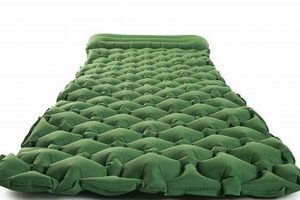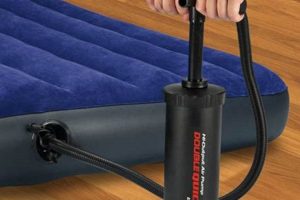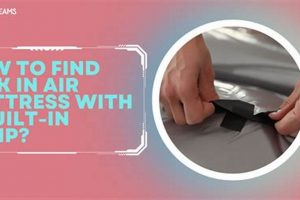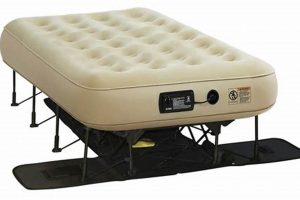The process of fixing punctures or tears in inflatable sleeping pads is essential for maintaining their functionality and extending their lifespan. Damage, often caused by sharp objects or excessive pressure, can render these items unusable, impacting comfort and convenience.
Addressing these damages promptly prevents air leakage, ensuring a stable and comfortable sleeping surface. Repairing, rather than replacing, such items offers economic advantages and reduces waste, contributing to more sustainable practices. This extends back to the original creation of such inflatable solutions and their continual refinement.
Therefore, understanding the methods for effectively sealing these breaches is paramount. This article will explore various techniques, materials, and tools necessary for successfully restoring an inflatable sleeping pad to its original, functional state.
Essential Techniques for Mending an Inflatable Sleeping Pad
The following guidelines offer practical advice for addressing punctures and tears in inflatable sleeping pads, ensuring effective and long-lasting repairs.
Tip 1: Locating the Leak: Submerge the inflated pad in water, or apply soapy water to its surface. Bubbles will indicate the precise location of the air escaping.
Tip 2: Cleaning the Area: Thoroughly clean the area surrounding the puncture with isopropyl alcohol to remove dirt, grease, and debris. This ensures proper adhesion of the repair material.
Tip 3: Selecting the Appropriate Adhesive: Choose a flexible adhesive specifically designed for vinyl or rubber, depending on the pad’s material. Cyanoacrylate-based glues (super glue) often become brittle and are not recommended.
Tip 4: Applying the Patch: Cut a patch that extends at least one inch beyond the puncture in all directions. Apply a thin, even layer of adhesive to both the patch and the prepared area on the pad. Allow the adhesive to become tacky before applying the patch.
Tip 5: Applying Pressure: After applying the patch, apply firm, even pressure for several minutes. Use a smooth, hard object, such as a rolling pin or the back of a spoon, to ensure a strong bond.
Tip 6: Allowing Sufficient Curing Time: Allow the adhesive to cure completely according to the manufacturer’s instructions, typically at least 24 hours, before reinflating the pad.
Tip 7: Reinforcing Large Tears: For larger tears, consider using a fabric-reinforced patch for added strength and durability.
Adhering to these steps significantly increases the likelihood of a successful repair, extending the lifespan of the inflatable sleeping pad and preserving its intended functionality.
With these practical tips at hand, anyone can efficiently repair damaged inflatable sleeping pads, ensuring continued comfort and convenience.
1. Leak Identification
Effective execution of procedures requires precise determination of the source of air egress. Failure to accurately locate the puncture or tear renders subsequent repair efforts futile. The introduction of patching material over an undamaged area will not resolve the problem. Furthermore, an undetected, slow leak may cause continued deflation, leading to user discomfort and potentially misdiagnosis of the issue.
A common method for leak identification involves submerging the inflated sleeping pad in water. Escaping air creates bubbles, visually indicating the leak’s precise location. Alternatively, applying soapy water to the surface produces similar results. Identifying multiple leaks is not uncommon, especially in older or heavily used sleeping pads. Marking each leak with a pen or marker ensures that all damaged areas receive appropriate attention during the repair process.
In summary, leak identification is a fundamental and indispensable step in restoring an inflatable sleeping pad. Without accurate identification, repair efforts are unlikely to succeed, resulting in continued air loss and compromised functionality. Investing time in thorough leak detection ultimately ensures a more effective and durable repair.
2. Surface Preparation
Optimal adhesion of repair materials to an inflatable sleeping pad hinges on meticulous surface preparation. The integrity of the bond, and therefore the longevity of the repair, is directly proportional to the cleanliness and condition of the area surrounding the puncture.
- Removal of Contaminants
The presence of dirt, grease, oils, or other foreign substances inhibits the adhesive’s ability to form a strong bond with the pad’s material. Isopropyl alcohol is frequently employed as a cleaning agent due to its effectiveness in dissolving such contaminants without damaging the sleeping pad material. Inadequate removal of these substances can result in a weak or incomplete seal, leading to subsequent air leakage.
- Abrasive Treatment
Lightly abrading the surface with fine-grit sandpaper or a similar abrasive material can increase the surface area available for bonding. This creates microscopic irregularities that allow the adhesive to grip the material more effectively. Caution must be exercised to avoid excessive abrasion, which could weaken or damage the sleeping pad further.
- Drying and Degassing
Following cleaning, the surface must be thoroughly dried to eliminate any residual moisture or cleaning agents. Allowing sufficient time for the cleaned area to degas prevents the formation of bubbles or voids in the adhesive layer, which would compromise the strength of the bond. Premature application of the patch before complete drying can trap moisture, fostering mold growth and adhesive degradation.
- Material Compatibility Assessment
Certain cleaning agents or adhesives may react adversely with the specific material of the inflatable sleeping pad (e.g., PVC, TPU, nylon). Testing the chosen cleaning agent and adhesive on a discrete, inconspicuous area of the pad before applying them to the damaged area helps to ensure material compatibility and prevent unintended damage or degradation. Such testing can avert costly repairs or the need for complete replacement of the pad.
The convergence of these preparatory measures significantly enhances the effectiveness of any puncture repair. By prioritizing surface cleanliness, texture, dryness, and material compatibility, the likelihood of achieving a durable, airtight seal is substantially increased, thus prolonging the lifespan of the inflatable sleeping pad and preserving its intended functionality.
3. Adhesive Selection
Adhesive selection directly influences the success and longevity of any inflatable sleeping pad repair. Choosing an inappropriate adhesive can lead to bond failure, negating all prior preparation efforts and potentially causing further material degradation. A deliberate, informed decision is therefore essential.
- Material Compatibility
The composition of the inflatable sleeping pad, often PVC, TPU, or nylon-based, dictates the range of suitable adhesives. Using an adhesive chemically incompatible with the pad’s material can result in bond degradation, material distortion, or even melting. Manufacturers’ specifications and product datasheets should be consulted to ensure compatibility.
- Flexibility and Elasticity
Inflatable sleeping pads undergo constant flexing and stretching during use. A rigid adhesive will likely crack or delaminate under these conditions, leading to air leakage. Flexible adhesives designed to accommodate movement are crucial for maintaining a durable, airtight seal. Products labeled for vinyl or rubber repair often possess the necessary elasticity.
- Water Resistance
Inflatable sleeping pads are frequently used in outdoor environments, exposing them to moisture and humidity. Water-resistant adhesives prevent bond degradation due to moisture penetration, maintaining the integrity of the repair over time. Adhesives formulated for marine or outdoor applications typically offer enhanced water resistance.
- Curing Properties
Adhesives vary in their curing time and final bond strength. Rapid-curing adhesives may be desirable for quick repairs, but slower-curing formulations often yield stronger, more durable bonds. The manufacturer’s recommended curing time should be strictly adhered to for optimal results. Additionally, environmental conditions, such as temperature and humidity, can affect the curing process.
Therefore, the careful consideration of material compatibility, flexibility, water resistance, and curing properties during adhesive selection directly contributes to the efficacy of the effort. A well-chosen adhesive, properly applied, ensures a reliable, long-lasting repair that restores the inflatable sleeping pad to its intended functionality. Neglecting these parameters increases the risk of repair failure and potential need for complete replacement.
4. Patch Application
The method of affixing a patch to the damaged area of an inflatable sleeping pad is a critical determinant of a successful repair. Inadequate application compromises the airtight seal, rendering prior preparation and adhesive selection ineffective.
- Patch Size and Shape
The dimensions of the patch must exceed the perimeter of the puncture or tear by a significant margin, typically at least one inch in all directions. This ensures sufficient surface area for adhesive bonding and distributes stress across a wider area. Rounded or oval shapes are preferable to squares or rectangles, as they minimize stress concentrations at the corners, reducing the likelihood of peeling.
- Uniform Adhesive Distribution
An even, consistent layer of adhesive must be applied to both the patch and the prepared area on the sleeping pad. Excessive adhesive can create a thick, inflexible layer that is prone to cracking, while insufficient adhesive results in a weak bond. A small brush or applicator can facilitate uniform distribution. The adhesive should be allowed to become tacky before the patch is applied, promoting optimal adhesion.
- Air Bubble Elimination
During patch application, care must be taken to prevent the formation of air bubbles between the patch and the sleeping pad. Trapped air compromises the bond and creates potential pathways for air leakage. Starting from the center of the patch and working outwards, gently press the patch onto the prepared surface, smoothing out any wrinkles or folds. Applying firm, even pressure for several minutes ensures complete contact and eliminates trapped air.
- Material Compatibility of Patch
Selecting a patch material that is compatible with the sleeping pad is essential. Using a patch made of incompatible material can lead to delamination and bond degradation. Most repair kits include patches made of similar materials to the inflatable sleeping pads such as PVC, TPU, or rubber. Always check material compatibility before applying a patch on inflatable sleeping pad.
The described aspects of patch application are intrinsically linked to the overall success of the repair. Adherence to these guidelines maximizes the likelihood of achieving a durable, airtight seal, thereby extending the lifespan and functionality of the inflatable sleeping pad. A poorly applied patch, regardless of the quality of other repair steps, ultimately leads to failure.
5. Pressure Application
Consistent and adequate pressure application is a critical, often understated, component of repairing punctures in inflatable sleeping pads. Without it, the adhesive may not properly bond to both the patch and the pad’s surface, resulting in a weak, incomplete seal. This inadequate bond allows air to escape, negating previous steps taken to prepare the surface and select the correct adhesive. Pressure application, in essence, determines the structural integrity of the repair.
The purpose of applying pressure is multifaceted. It forces the adhesive to intimately contact both surfaces, maximizing the surface area of the bond. It eliminates air pockets that may have formed during patch placement, which can weaken the adhesive layer. Furthermore, it ensures the patch conforms to the contours of the sleeping pad, preventing edges from lifting or peeling over time. For instance, consider a scenario where an individual quickly applies a patch and fails to apply consistent pressure. The patch may appear secure initially, but the lack of a strong bond will cause it to detach under the stress of inflation and use, resulting in air leakage. Practical experiments and field experiences consistently demonstrate that insufficient pressure leads to premature failure of the repair.
In conclusion, the connection between pressure application and successful sleeping pad repair is undeniable. This procedure is not a mere afterthought but an essential step in ensuring a durable and airtight seal. Neglecting to apply consistent and adequate pressure significantly increases the risk of repair failure. Comprehending its fundamental role is vital for anyone seeking to effectively mend an inflatable sleeping pad and maintain its long-term usability.
6. Curing Duration
The timeframe allotted for adhesive curing is a crucial determinant in the overall effectiveness when addressing punctures or tears. The chemical processes involved in adhesive bonding necessitate a specific duration to achieve optimal strength and resilience. Premature use of the repaired inflatable sleeping pad, before the adhesive has fully cured, can lead to bond failure, rendering the repair ineffective and potentially exacerbating the initial damage.
The relationship
is directly proportional. Insufficient curing time results in a weaker bond and a higher probability of air leakage. Consider a scenario where an inflatable sleeping pad is patched and inflated after only a few hours of curing. While the patch may appear to hold initially, the stress of inflation and subsequent use can cause the uncured adhesive to fail, leading to a separation of the patch from the pad. Conversely, adhering to the manufacturer’s recommended curing duration allows the adhesive to fully crosslink, resulting in a robust and durable seal capable of withstanding repeated use and inflation cycles. Environmental factors, such as temperature and humidity, can also influence the curing process, potentially requiring adjustments to the recommended curing duration.
In summary, the curing duration is not merely a suggested timeframe but an integral component of the repair process. Adherence to recommended curing times, adjusted for environmental considerations, directly impacts the success of the repair. Neglecting this aspect can lead to premature failure, undermining all preceding efforts and potentially necessitating further repairs or complete replacement of the inflatable sleeping pad. Understanding and respecting curing duration ensures a reliable and lasting repair.
Frequently Asked Questions
The subsequent questions address common issues encountered during the repair of inflatable sleeping pads, providing objective information to ensure successful and durable outcomes.
Question 1: What constitutes an irreparable puncture in an inflatable sleeping pad?
Damage exceeding one-third the surface area of the pad, extensive seam separation, or significant material degradation often renders repair economically unfeasible. Replacement is typically recommended in such instances.
Question 2: Is it possible to repair a puncture located on a seam?
Seam repairs present a greater challenge due to increased stress concentration. The patch must overlap the seam by a significant margin, and a flexible adhesive is crucial to accommodate the seam’s inherent movement. Reinforcement with fabric may be necessary.
Question 3: What type of adhesive is unsuitable for repairing inflatable sleeping pads?
Rigid adhesives, such as cyanoacrylate (super glue), are inappropriate due to their inflexibility. They tend to crack under stress, leading to bond failure. Similarly, solvent-based adhesives may damage the pad’s material.
Question 4: What factors influence the curing time of an adhesive used for inflatable sleeping pad repair?
Ambient temperature, humidity, and the specific adhesive formulation significantly affect curing time. Higher temperatures and lower humidity generally accelerate curing, while manufacturer’s instructions provide precise guidance.
Question 5: How can patch peeling be prevented after repairing a puncture?
Thorough surface preparation, the use of a compatible adhesive, adequate pressure application during curing, and ensuring the patch extends well beyond the damaged area minimizes the risk of peeling.
Question 6: What precautions should be observed when using repair kits in confined spaces?
Adequate ventilation is essential when working with adhesives, as many emit volatile organic compounds. Avoid open flames or sparks, and follow the manufacturer’s safety guidelines meticulously.
Adherence to these guidelines promotes effective repairs, extending the service life of inflatable sleeping pads.
The following section addresses long-term maintenance for inflatable sleeping pads.
Conclusion
This examination of the process underscores the systematic approach required to effectively address damage. Accurate leak identification, meticulous surface preparation, appropriate adhesive selection, precise patch application, consistent pressure application, and adherence to curing duration collectively determine the success of any repair attempt. Neglecting any of these phases compromises the outcome and diminishes the lifespan of the equipment.
Mastering these techniques empowers individuals to prolong the functionality of inflatable sleeping pads, reducing waste and minimizing the need for frequent replacements. Employing the knowledge and skills provided herein ensures preparedness for unforeseen circumstances, contributing to both economic efficiency and environmental responsibility.







![Best Air Mattress Alternative [Top Picks!] Organic & Natural Mattress Buyer’s Guide: Non-Toxic Sleep Solutions Best Air Mattress Alternative [Top Picks!] | Organic & Natural Mattress Buyer’s Guide: Non-Toxic Sleep Solutions](https://mattressworldpa.com/wp-content/uploads/2025/07/th-6618-300x200.jpg)